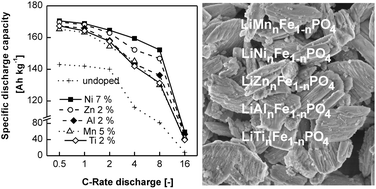Microwave-assisted solution synthesis of doped LiFePO4 with high specific charge and outstanding cycling performance†
Abstract
A microwave-assisted liquid-phase synthesis route to LiFePO4 doped with divalent (Mn, Ni, Zn), trivalent (Al) and tetravalent (Ti) metal ions in varying concentrations is presented. In spite of the low synthesis temperature of 180 °C all the as-synthesized powders are highly crystalline. The short reaction times of just a few minutes represent the basis for an efficient and time-saving screening of different types of dopants with respect to optimized electrochemical performance in lithium-ion batteries. The Ni- and Zn-doped LiFePO4 with nominal dopant concentrations of 7 and 2 mol%, respectively, outperformed all the other samples, offering initial specific charge of 168 A h kg−1 and excellent capacity retention of 97% after 300 full cycles. A discharge rate of 8 C still resulted in 152 A h kg−1 after 50 cycles. The electrochemical investigations are accompanied by a detailed structural and morphological characterization. Whereas the elemental composition, obtained from quantitative


 Please wait while we load your content...
Please wait while we load your content...